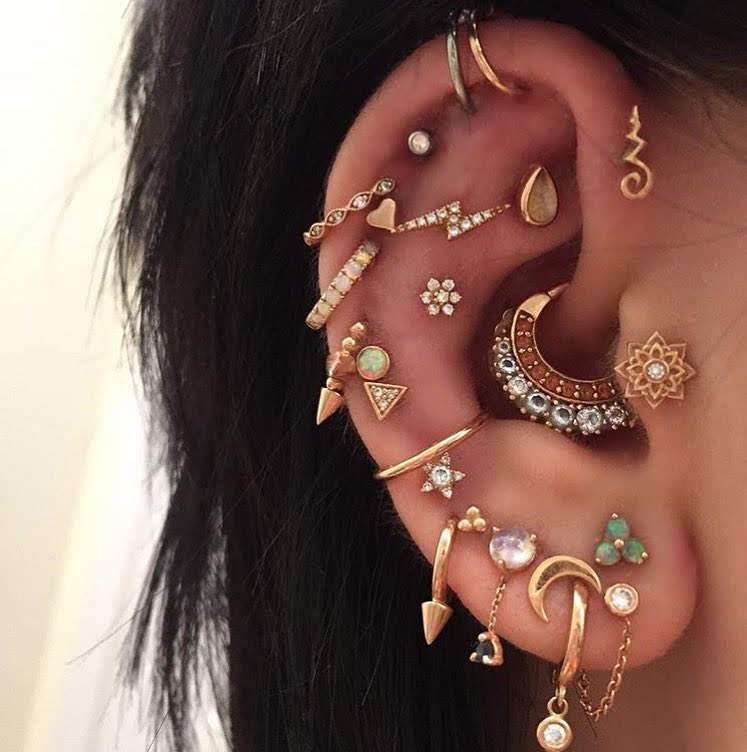Selecting the suitable material for your piercing jewelry is essential for ensuring safety, durability, and comfort. The material you choose can significantly impact the healing process, the longevity of the jewelry, and your overall satisfaction with the piercing. This article will explore the best materials for various piercings, discussing their benefits, potential drawbacks, and suitability for different types of piercings. Whether you’re considering a new piercing or looking to switch out your jewelry, understanding these materials will help you make informed decisions.
The Importance of Choosing the Right Material
When it comes to body jewelry, not all materials are created equal. The right material can promote healing, reduce the risk of infection, and provide long-term comfort. Conversely, the wrong material can cause irritation, allergic reactions, and prolonged healing.
- Safety and Biocompatibility: Choosing biocompatible materials reduces the risk of adverse reactions and ensures that your body can accept the jewelry.
- Durability and Longevity: High-quality materials last longer, maintaining their appearance and integrity over time.
- Aesthetic Appeal: Different materials offer various looks, allowing you to match your jewelry to your personal style.
Surgical Steel: The Gold Standard for Piercings
Surgical steel is a popular and widely used material for piercing jewelry. It is known for its durability, affordability, and hypoallergenic properties.
Benefits:
- Biocompatibility: Surgical steel is less likely to cause allergic reactions or irritation, making it a safe choice for most people.
- Durability: It is highly resistant to scratching and tarnishing, ensuring the jewelry looks good for a long time.
- Affordability: Surgical steel jewelry is relatively inexpensive, making it accessible for various budgets.
Drawbacks:
- Nickel Content: Some surgical steel alloys contain trace amounts of nickel, which can cause reactions in individuals with severe nickel allergies.
Titanium: The Premium Choice for Sensitive Skin
Titanium is another top choice for piercing jewelry, especially for those with sensitive skin or allergies. It is incredibly strong, lightweight, and completely hypoallergenic.
Benefits:
- Hypoallergenic: Titanium is free of nickel and other allergens, making it ideal for sensitive skin.
- Strength and Lightness: Despite its strength, titanium is very lightweight, providing comfort for daily wear.
- Corrosion Resistance: Titanium is highly resistant to corrosion and tarnish, maintaining its appearance over time.
Drawbacks:
- Cost: Titanium jewelry is generally more expensive than surgical steel due to its superior properties.
Gold: Classic Elegance with Hypoallergenic Properties

Gold is a timeless and elegant choice for body jewelry, available in various karats and colors. When choosing gold for piercings, it’s important to opt for high-quality gold to avoid complications.
Benefits:
- Hypoallergenic: Pure gold (24 karats) is hypoallergenic, reducing the risk of allergic reactions.
- Aesthetic Appeal: Gold jewelry offers a classic, luxurious look that never goes out of style.
- Variety: Available in yellow, white, and rose gold, allowing for diverse stylistic choices.
Drawbacks:
- Softness: Pure gold is very soft and can bend or scratch easily. For a balance of purity and durability, 14k or 18k gold is recommended.
- Cost: Gold jewelry is often more expensive than other materials.
Niobium: A Versatile and Safe Alternative
Niobium is a versatile, biocompatible metal that can be anodized to produce a variety of colors. It is a great option for those looking for hypoallergenic jewelry with unique aesthetic options.
Benefits:
- Hypoallergenic: Niobium is biocompatible and safe for most people.
- Color Options: Can be anodized to create vibrant colors, adding a unique touch to your jewelry.
- Durability: Resistant to corrosion and tarnishing.
Drawbacks:
- Availability: Niobium jewelry is less common and may be harder to find than other materials.
Bioplast: Flexible and Comfortable for Initial Piercings
Bioplast is a type of medical-grade plastic that is flexible, hypoallergenic, and ideal for initial piercings. It offers comfort and safety during the healing process.
Benefits:
- Flexibility: Bioplast’s flexibility reduces stress on healing piercings, promoting faster recovery.
- Hypoallergenic: Free of allergens, making it safe for sensitive skin.
- Customization: Can be easily cut to size and adapted for various piercings.
Drawbacks:
- Less Durable: Not as durable as metal options and may need to be replaced more frequently.
Choosing the Right Material for Your Piercing
When selecting jewelry material, consider the type of piercing, your skin sensitivity, and personal preferences. Here are some recommendations for different piercings:
Ear Piercings :
- Best Materials: Surgical steel, titanium, gold
- Considerations: Ensure the material is hypoallergenic to avoid irritation.
Nose Piercings :
- Best Materials: Titanium, gold, niobium
- Considerations: Choose materials that are biocompatible and won’t cause reactions.
Oral Piercings :
- Best Materials: Bioplast, titanium
- Considerations: Opt for flexible and hypoallergenic materials to avoid damaging teeth and gums.
Body Piercings :
- Best Materials: Surgical steel, titanium, niobium
- Considerations: Prioritize biocompatibility and durability for long-term wear.
Choosing the right material for your piercing jewelry is crucial for ensuring safety, comfort, and longevity. Materials like surgical steel, titanium, gold, niobium, and bioplast each offer unique benefits that cater to different needs and preferences. By understanding the properties and suitability of each material, you can make informed decisions that enhance your piercing experience and minimize the risk of complications. Whether you’re opting for the durability of surgical steel, the hypoallergenic nature of titanium, or the elegance of gold, selecting the best material will ensure that your body jewelry looks great and feels great.



